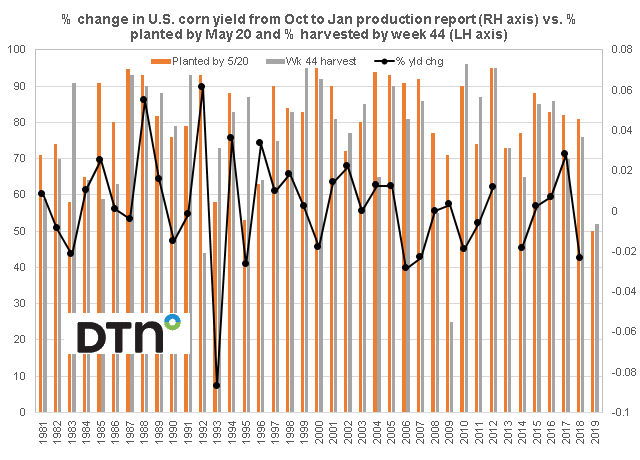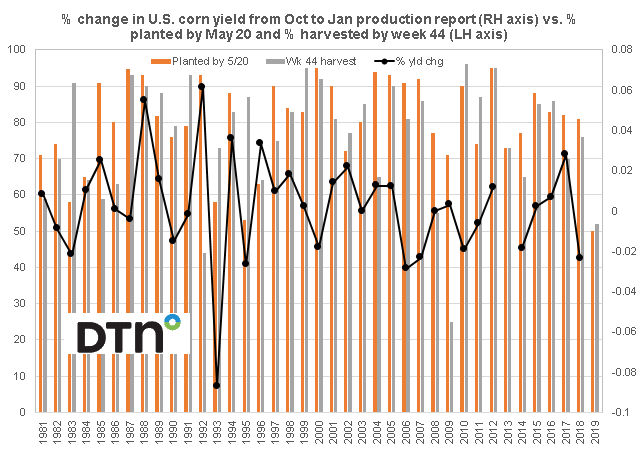Fundamentally Speaking
Delayed Corn Plantings vs. Delayed Harvesting
USDA reported that as of November 3, week 44 of the calendar year, only 52% of the nation's corn crop had been harvested; other than the 25% harvested figure in 2009 is the slowest rate of corn harvesting since at least 1981.
The question we have is with all the corn out there being subjected to a variety of adverse weather conditions, will this result in lower harvested acreage and yields, not only in this Friday's crop production report but also the one due out 1/10/20.
Note that 2018 corn yields fell by 4.3 bushels per acre (bpa) from the October to January report last year with harvest conditions reportedly worse this year than last.
The accompanying graphic shows the percent change in USDA's U.S. corn yield estimate from the October to the January crop production reports on the right hand axis (with the exception of 2013 when a government shutdown prevented the release of a number of government reports in October 2013 including crop production and WASDE figures).
On the left hand axis is the percent of the U.S. corn crop harvested by week 44 (usually coinciding with November 1) and the percent of the U.S. corn crop planted by May 20.
P[L1] D[0x0] M[300x250] OOP[F] ADUNIT[] T[]
We had thought that maybe a late harvest would correlate with October to January corn yield declines with the crop more subject to rains, snow, freezing temperatures, winds and other weather considerations.
Interesting to note that even with the advent of faster maturing seeds and better harvesting equipment, the average pace of corn harvested by week 44 was the same 76% from 1981 to 1999 as it was from 2000 to 2018.
Also interesting is some of the largest October to January yield declines came in years when harvesting proceeded rather smoothly.
Last year's 2.38% decline came with the crop 76% harvested as of week 44; a 2.33% yield drop in 2007 came with 86% of the crop harvested as of week 44; the year prior's 2.87% drop came with 81% of the crop harvested; a 2.66% drop in 1995 with 87% of the crop harvested; and a 2.17% yield drop in 1993 when 91% of the crop was harvested by week 44.
Even the largest decline ever posted from the October to the January report in 1993 of 8.70% had 73% of the crop harvested that year.
Looking at the data there is actually a higher correlation between Oct to Jan yield revisions and percent of corn seeded by May 20 than the percent harvested by week 44.
This year's 50% planted by May 20 was the slowest ever at 50%.
The only years under 60% planted by May 20 was 1983 at 58%, 1993 at 58% and 1995 at 53%, all years with October to January yield declines of at least 2%.
We should note that large Oct to Jan yield declines did come in 2006 and 2007, though seedings by May 20 those seasons were relatively quick at 91% and 92% respectively.
(KLM)
© Copyright 2019 DTN/The Progressive Farmer. All rights reserved.






Comments
To comment, please Log In or Join our Community .